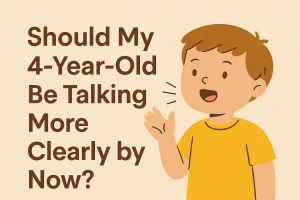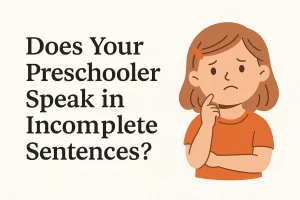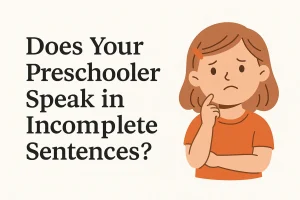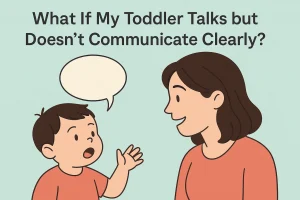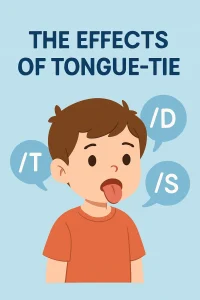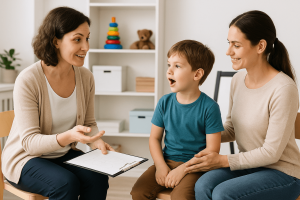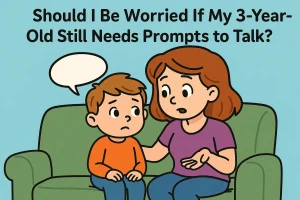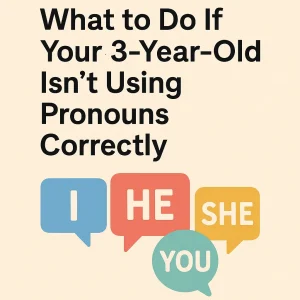Speech or Social Delay? How to Tell If Your Child Needs Support
By Wellness Hub
Last Updated: August 23, 2025
As a parent, it’s natural to worry when your child isn’t hitting their communication milestones. Maybe your toddler isn’t talking as much as other kids their age—or perhaps they speak words clearly but struggle to make eye contact, play pretend, or join in back-and-forth conversations. This leaves many parents asking the same question: “Is it a speech delay or social delay—and how can I tell the difference?”
Understanding the difference between speech delay, language delay, and social communication delay is key to getting the right support at the right time. While some children are simply “late talkers,” others may need help from a speech-language pathologist (SLP) or early intervention program. Knowing the red flags—like not responding to their name, limited vocabulary, or difficulty with pretend play—can help you recognize whether your child needs extra support.
Free Speech Help for Kids
Concerned about speech delays? Book a free consultation with our expert speech therapist and get guidance tailored to your child’s needs.
Speech or Social Delay? Understanding the Difference
When your child isn’t keeping up with peers in communication, it can feel confusing and worrying. Parents often wonder: Is this a speech delay or social delay? Understanding the difference is the first step toward helping your child.
Speech delay:
It means a child struggles with using sounds, words, or sentences to express themselves. For example, they may say fewer words than expected for their age, mix up sounds, or have trouble forming sentences. This is about verbal communication—how clearly and effectively a child can use language to share ideas.
Also read: Speech Therapy at Home for Kids with Speech Delays
Social delay:
On the other hand, affects how a child interacts with others. A child may speak words but struggle with social skills like making eye contact, taking turns in conversation, playing pretend, or responding when someone calls their name. This is about connection and interaction, not just talking.
Think of it this way: speech delay is about “how we talk,” while social delay is about “how we connect.” Both are forms of communication delay, but they show up in different ways. Some children may even have a mix of both—speaking fewer words and finding it difficult to use those words in social situations.
It’s also important to understand the link with language delay, which is slightly different. While speech delay focuses on the sounds and words a child produces, language delay covers both understanding and expressing meaning. A child with language delay might understand less of what you say or struggle to put words together, even if their speech sounds are clear.
By knowing the difference between speech delay, social delay, and language delay, you can better recognize what kind of support your child may need. Early awareness is key—because the sooner you know what’s happening, the sooner you can guide your child toward stronger communication and social skills.
What Is Speech Delay? (Signs, Causes & Milestones)
A speech delay happens when a child isn’t developing speech skills at the expected pace for their age. This can look different for every child, but it often shows up in the way they use sounds, words, and sentences to communicate. Unlike shyness or being a “late bloomer,” a true speech delay usually requires support and guidance to help a child catch up.
Signs of Speech Delay
Some children are “late talkers,” but others show consistent patterns that point to a delay. Common signs of speech delay include:
- Late talking: By 18 months, most children use at least a few meaningful words. A child with speech delay may use very few or none.
- Unclear speech: Words may sound jumbled, missing sounds, or be difficult for others (even parents) to understand. This may point to an articulation delay or a speech sound disorder.
- Limited vocabulary: A child may repeat the same few words instead of learning new ones regularly.
- Difficulty forming sentences: Even when words are present, stringing them together (“want juice,” “go park”) may be a struggle.
Causes of Speech Delay
Speech development depends on many factors. Some of the most common causes of speech delay include:
- Hearing loss: If a child can’t hear sounds clearly, they may not be able to imitate or produce them correctly. This is why hearing checks are so important.
- Developmental language disorder: Some children have difficulties with the rules and patterns of language itself, making it harder to learn words and grammar.
- Neurological or developmental conditions: Conditions like childhood apraxia of speech or global developmental delays can affect speech progress.
- Environment and exposure: Limited opportunities for back-and-forth communication may slow down a child’s speech growth.
Speech Milestones by Age
Every child grows at their own pace, but there are clear speech milestones to watch for:
- 12 months: Says “mama,” “dada,” or simple words; babbles with intent; may point and make sounds to get your attention.
- 18 months: Has a vocabulary of about 10–20 words; can imitate new words; uses gestures and words together.
- 24 months (2 years): Says 50+ words; combines two words (“more milk,” “bye-bye daddy”); speech understood by parents most of the time.
- 30 months (2.5 years): Uses short sentences (3–4 words); vocabulary rapidly expanding; strangers can understand at least half of what the child says.
If a child is far behind these milestones, it doesn’t always mean something serious—but it does signal the need to check in with a pediatrician or a speech-language pathologist (SLP). The earlier the support, the faster children can catch up and thrive.
What Is Social Delay? (Signs, Causes & Red Flags)
A social delay happens when a child struggles with skills that involve connecting, interacting, and building relationships with others. While a speech delay focuses on how children talk, a social communication delay highlights how children use language and behavior to connect. These skills are often called social-emotional skills, and they are just as important for development as learning to speak.
Children with a social-emotional delay may understand words or even speak clearly, but they might not know how to use those words in back-and-forth play, to make friends, or to share experiences. These challenges are sometimes linked to conditions like pragmatic language disorder or broader developmental differences such as autism.
Signs of Social Delay
Parents are usually the first to notice when something feels “different” in their child’s social behavior. Common signs of social delay include:
- Limited eye contact: Avoids or rarely makes eye contact during play or conversation.
- No pointing or gestures: Doesn’t point to objects of interest or wave “bye-bye.”
- Poor pretend play: Doesn’t engage in make-believe activities like feeding a doll or pretending a block is a car.
- Difficulty with back-and-forth interaction: May not respond to their name, avoid taking turns, or struggle to share toys.
- Few friendships or peer connections: Has a hard time joining group play or showing interest in other children.
Causes of Social Communication Delay
A social communication delay can have many possible causes, including:
- Autism spectrum disorder (ASD): Social difficulties are a core feature of autism, often seen in limited eye contact, trouble with pretend play, or challenges in making friends.
- Pragmatic language difficulties: Some children speak well but struggle with the “rules” of conversation, such as knowing when to talk, how to stay on topic, or how to adjust tone for different people.
- Developmental differences: Broader social-emotional delays may occur alongside global developmental delays or sensory challenges that affect interaction.
Social Milestones by Age
Social development follows a predictable path. Knowing these social milestones helps parents spot potential red flags:
- 12 months: Looks at parents to share attention (joint attention), smiles back when smiled at, uses simple gestures like waving.
- 18 months: Points to show interest, engages in simple play with others, starts to show affection.
- 24 months (2 years): Imitates actions, plays simple pretend games (like cooking or driving toy cars), enjoys being around peers.
- 30 months–3 years: Takes turns in games, begins cooperative play, uses words in social ways (“your turn,” “come play”), starts making friends.
If your child consistently misses these milestones or shows several red flags, it may point to a social-emotional delay. Early recognition is important—because with the right support, children can learn the social and communication skills they need to build connections and thrive in relationships.
Speech Delay vs Social Delay vs Autism
It’s common for parents to ask, “Does speech delay mean autism?” The short answer is no—but understanding the differences (and overlaps) between speech delay, social delay, and autism is very important.
A speech delay is mainly about how a child produces sounds, words, and sentences. A child may have a small vocabulary, unclear words, or trouble forming sentences—but they might still enjoy playing with others, making eye contact, and sharing attention.
A social delay, on the other hand, focuses on how a child uses communication in interactions. A child with social communication disorder, for example, may speak clearly but struggle to hold conversations, use gestures, or play pretend with peers. This is less about talking and more about connecting.
Autism spectrum disorder (ASD) can sometimes include both. Many children with autism have a mix of speech delay and social delay, but autism also comes with unique red flags that go beyond speech alone.
Key Red Flags for Autism
- Not responding to name: By 12 months, most children look up when called. Lack of response may be an early warning sign.
- Limited pretend play: Pretend games like feeding a doll or pretending to drive a toy car often don’t emerge naturally.
- Echolalia: Repeating words or phrases instead of using them meaningfully in conversation.
- Rigid routines or sensory sensitivities: Upset by changes or overly focused on certain objects/activities.
Overlaps & Distinctions
- A child with speech delay may say “car” as “ca” but still point to it, show excitement, and invite you to play with it.
- A child with social delay may say “car” clearly but not use it to start a game or include you in the play.
- A child with autism may show both—struggles with speech and difficulties with social interaction, alongside other developmental differences.
In short, while speech delay vs autism and social delay vs autism share similarities, they are not the same thing. Many children with speech or social delays catch up beautifully with the right therapy, while autism often requires ongoing, specialized support.
Speech Delay vs Language Delay – Know the Difference
Parents often hear the terms “speech delay” and “language delay” used interchangeably, but they are not the same. Knowing the difference helps you understand your child’s challenges and the type of support they may need.
A speech delay is about the sounds and clarity of spoken words. Children with speech delay may struggle to pronounce certain sounds, leave out parts of words, or have speech that is difficult for others to understand. This is a problem of how words are spoken.
A language delay, on the other hand, is about understanding and using words meaningfully. Language includes both:
- Expressive language – how a child uses words, sentences, and grammar to express themselves.
- Receptive language – how a child understands and processes what others say.
For example:
- A child with speech delay may try to say “ball” but it comes out as “ba.” They know the word and understand what it means, but their clarity is limited.
- A child with language delay may say “ball” clearly, but if you ask them to “put the ball on the table,” they might not understand the instruction. This shows a difficulty with comprehension (receptive language delay).
- Some children may struggle with both—pronouncing words and understanding or using them correctly.
Think of it this way: speech = sounds and clarity; language = words, meaning, and understanding. Both are critical for communication, but they require different strategies and therapy approaches.
If your child is talking but not always understood, that leans toward a speech delay. If your child speaks clearly but doesn’t understand instructions or struggles to form sentences, that points more to a language delay. In either case, a speech-language pathologist (SLP) can evaluate and guide the best next steps.
Developmental Milestones Checklist (Speech + Social)
Tracking your child’s growth through communication milestones by age is one of the best ways to know if they’re on the right path—or if they might need extra support. These milestones include both toddler speech milestones and social milestones, since speech and social skills often develop hand-in-hand.
Below is a simple checklist to help you see what most children are doing by age 1, 2, and 3 years. Remember: every child develops at their own pace, but missing several milestones may signal a delay.
By 12 Months (1 Year)
- Speech milestones: Babbles with different sounds (“ba-ba,” “da-da”), says simple words like “mama” or “dada.”
- Social milestones: Smiles back at people, makes eye contact, responds to their name, uses simple gestures like waving.
- Red flag: Not babbling or making sounds, no response to name.
By 24 Months (2 Years)
- Speech milestones: Uses 50 or more words, begins combining words (“more milk,” “go park”), speech understood by parents most of the time.
- Social milestones: Points to show interest, plays alongside other children, shows affection to familiar people, uses gestures and words together.
- Red flag: No meaningful words, no two-word phrases, very limited interest in others.
By 30–36 Months (2.5 to 3 Years)
- Speech milestones: Speaks in 3–4 word sentences, vocabulary grows quickly, strangers can understand at least half of what they say.
- Social milestones: Takes turns in games, enjoys pretend play (like cooking or caring for dolls), starts playing with peers instead of just beside them.
- Red flag: No pretend play by 30 months, very little interest in interaction, difficulty using words socially.
Why These Milestones Matter
Early speech and social milestones are more than checkboxes—they’re windows into how your child is learning to communicate and connect. If your child is missing multiple red flags, it doesn’t automatically mean something serious, but it’s a sign to talk with a pediatrician or speech-language pathologist (SLP). With early support, many children catch up and thrive.
When to Seek Help – Early Intervention Matters
Every child develops at their own pace, but there are times when waiting and hoping isn’t the best choice. Knowing when to seek speech therapy or a professional evaluation can make a big difference in your child’s future communication skills.
Signs It’s Time to Call an SLP
A speech-language pathologist (SLP) specializes in helping children with speech, language, and social communication. You may want to seek help if your child:
- Isn’t babbling or saying single words by 12–18 months.
- Has no two-word phrases by 24 months.
- Is difficult to understand, even for parents.
- Doesn’t use gestures, eye contact, or pretend play to connect socially.
- Seems frustrated or gives up easily when trying to communicate.
The Role of Early Intervention
Early intervention for toddlers is one of the most powerful tools for catching delays early. Research shows that the earlier therapy begins, the greater the progress a child can make. Early support can improve not just speech, but also social skills, confidence, and school readiness.
Developmental Pediatrician & Hearing Checks
Sometimes a delay is linked to underlying issues. A developmental pediatrician evaluation can help rule out broader developmental concerns, while a hearing screening ensures your child is hearing sounds clearly enough to imitate and learn from them. Regular pediatric check-ups also give you a chance to share concerns and track progress.
Why Acting Early Matters
The most important thing to remember is this: Don’t wait—support can make all the difference. Many children with speech or social delays catch up beautifully once they get the right help. Reaching out early doesn’t label your child—it empowers them to grow.
Supporting Speech and Social Skills at Home
While professional help is sometimes needed, parents play a powerful role in building everyday communication skills. The good news is that many strategies for speech therapy for toddlers and social skills training for preschoolers can be woven into daily routines and playtime. With a little consistency, these small steps can make a big difference.
Model Language During Play
Children learn language best by hearing it in natural, meaningful ways. When you play with your child, describe what you’re doing: “The car goes fast!” or “Let’s feed the doll some juice.” Modeling clear, simple language gives your child the words they need to copy and use. Repeating key words often also helps expand their vocabulary.
Encourage Gestures and Pretend Play
Communication isn’t just about words—it also includes gestures and imagination. Encourage your child to wave, clap, or point to objects. Pretend play, like cooking in a toy kitchen or caring for a stuffed animal, is more than fun—it builds joint attention and teaches children how to use language socially. Learning how to pretend play also prepares them for richer social interactions with peers.
Reduce Screen Time, Increase Interactive Play
While screens can be entertaining, they don’t replace real communication. Limiting screen time and focusing on face-to-face interaction gives your child more chances to practice. Singing songs together, reading picture books, building with blocks, or simply talking during mealtime all provide rich opportunities for learning speech and social skills.
Why Home Support Matters
Every interaction is a learning moment. By turning daily routines into opportunities for speech and social practice, parents can give their children a strong foundation. Combined with professional guidance when needed, these home strategies create the perfect balance of support.
Remember: progress often starts with small steps. Consistent modeling, play, and interaction at home can help your child grow in confidence and communication.
Conclusion
Many children experience speech delay or social delay, and it’s more common than most parents realize. The good news is that with early therapy and support, children can catch up and build strong communication skills. Watch for red flags such as no babbling by 12 months, no two-word phrases by 24 months, or no pretend play by 30 months. If you feel unsure, don’t wait—early intervention makes all the difference. Talk to your pediatrician or a speech-language pathologist (SLP) for guidance. Getting help early can give your child the confidence to grow, connect, and thrive.
Frequently Asked Questions:
1. What is the difference between speech delay and social delay?
A speech delay happens when a child struggles to say words clearly, form sentences, or use enough vocabulary for their age. A social delay is different—it shows up in how a child connects with others, like making eye contact, taking turns, or joining pretend play. Some children may have both speech and social delays.
2. Does speech delay mean autism?
Not always. Many children have a speech delay without autism and catch up with early therapy. Autism usually involves both speech and social communication delays, along with signs like not responding to name, repeating words (echolalia), or avoiding pretend play.
3. What are the signs of speech delay in toddlers?
Common signs include late talking, unclear words, very limited vocabulary, or difficulty putting two words together by age 2. Some children with articulation delays or speech sound disorders may be hard to understand even when they know words. These signs suggest it may be time to consult a speech-language pathologist (SLP).
4. What are the signs of social delay in toddlers?
Children with a social communication delay may avoid eye contact, not point to things they want, or ignore when their name is called. They might not play pretend games, share toys, or enjoy back-and-forth interaction with parents or peers. These are considered red flags for a social-emotional delay.
5. At what age should I worry about speech delay?
If your child isn’t babbling by 12 months, saying words by 18 months, or using two-word phrases by 24 months, it’s a good idea to ask for help. By 3 years, children should be understood by others at least 50–75% of the time. Delays beyond these points should be discussed with a pediatrician or SLP.
6. What milestones should my 2-year-old have in speech and social skills?
By 2 years, most toddlers say 50 or more words, use short two-word phrases like “more juice,” and can point to show what they want. Socially, they often play simple games with others, copy actions, and show affection toward familiar people. Missing these toddler speech milestones and social milestones may signal a delay.
7. When should I take my child to speech therapy?
If your child is hard to understand, speaks fewer words than expected, or seems frustrated when trying to communicate, it’s time to consider speech therapy for toddlers. Early support can help children catch up faster and build confidence. An SLP can also check for issues like expressive or receptive language delay.
8. How can I help my child with social communication delay at home?
You can encourage joint attention by pointing to objects and naming them together. Pretend play—like feeding a doll, cooking with toy food, or building a house with blocks—teaches important social skills. Limiting screen time and spending more time in face-to-face play builds stronger connections and supports social-emotional growth.
9. Can a child have social delay without speech delay?
Yes, it’s possible. Some children speak clearly but don’t know how to use language in social situations—for example, they may not take turns in conversation or may avoid playing with others. This can be linked to social communication disorder or autism, even when speech sounds are normal.
10. Who should I consult if I suspect a delay?
Your first step should be visiting your pediatrician. They may recommend a hearing screening to rule out hearing problems, a developmental pediatrician evaluation to check overall growth, or a referral to a speech-language pathologist (SLP) for therapy. The sooner you ask, the sooner your child can get the right support.
About the Author:
Shravanaveena Gajula
M.Sc ., Speech and Language Pathology (5+ years of experience)
Shravanaveena Gajula is a dedicated Audiologist and Speech-Language Pathologist with a BASLP and an M.Sc in Speech and Language Pathology. With experience spanning multiple settings, including Wellness Hub and Ashray Akruti, Veena specializes in a wide range of disorders from developmental issues in children to speech and language assessments in adults. Her expertise includes parent counseling, managing speech sound and fluency disorders, and creating individualized therapy programs. Veena is also PROMPT certified and an author of several insightful blogs on speech and language pathology, aiming to educate and assist caregivers in supporting their loved ones.
Book your Free Consultation Today
Parent/Caregiver Info:
Client’s Details:
* Error Message
